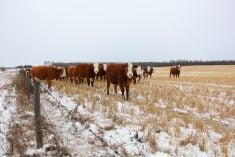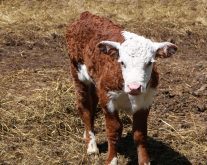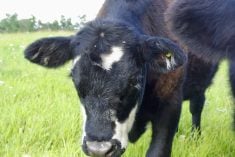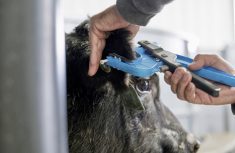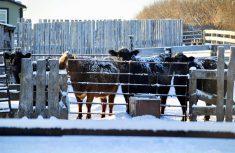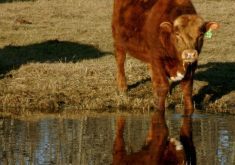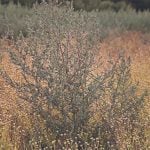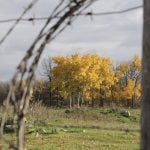With winter calving almost at a close, grassland producers are preparing for their own spring calving season.
Chad Ross calves his herd of 800 to 1,100 cows as close to nature as he can. The owner and operator of L-7 Land and Cattle at Estevan, Sask., switched to grassland calving in the mid-2000s. Unless a heifer is delivering for the first time or there’s trouble, his approach is very hands-off.
Calving in May just makes sense, he said.
Read Also

Canadian Beef Check-Off Agency reports on investments and activities
The check-off agency’s work behind the scenes is what ensures cattle check-off dollars are invested wisely, accounted for transparently and deliver measurable value back to producers and importers.
“That’s when the deer have their babies, and things just work better. Our first-time heifers, we’re checking them two and three times a day, just because it’s their first time, and if they need help, we’re there to assist. But cows have very little trouble. They just do it.”
Even with this hands-off approach, there are still lots of things that Ross can control as he manages his land and his herd.
Using rotational grazing, Ross is moving his herd every three to five days and can keep a close eye on all of his pregnant cows. Strong grass nutrition has meant strong milk production, oftentimes too much for a calf to feed on. Udder breakdown happens quicker in these instances, so Ross prefers animals with negative milk expected progeny differences (EPD). Ross said his cull rates increased exponentially on that factor alone.
“We found that the cows were milking too hard for the udder attachments that they had. We had to really focus on lower-producing milk cows, as well as good udder attachments to lower that cull rate.”
Calves born in late spring are usually weaned in December, said Ross, but he is willing to keep them with the mother cow until February or March if he has enough feed to do so. The longer the calf stays with its dam, the better it learns, he said.
“If you’re bringing females back into the herd, they tend to learn that they need to get out there and forage with their mother. They learn how to do that. They learn our system.”
Lauren Stefaniuk, registered veterinary technician at Veterinary Agri-Health Services Ltd. in Rocky View County, Alta., said producers should always be talking with their local vets or grazing specialists about the best moves for their herds. Overcrowding can be a challenge for pasture calving, but proper herd management is essential, said Stefaniuk who recommends the Sandhills system. While it does require quite a bit of space, this management practice provides the most disease risk mitigation, she said.
“Our goal is to keep calves in groups of similar age to reduce transmission of pathogens from older to younger calves,” said Stefaniuk.
When purchasing new cattle herds, which include pregnant mothers, Ross does his best to separate them with this land management practice. But in the past 25 years, he’s seen many producers getting out of the cattle business. Moving cattle as frequently as he does, they’ve had fewer problems with disease anyway, he said, but they can also successfully integrate new members of the herd.
Stefaniuk advises producers to quarantine any new animals for about two to three weeks, but there are also tests they can run during that period to ensure animals aren’t introducing any new problems into their herd. Johne’s disease, also known as paratuberculosis, has been a big concern for cattle producers, said Stefaniuk, and is highly contagious with no cure.
- RELATED: Managing a scours outbreak in calves
- RELATED: Scours prevention tips for calves
“Talk to your veterinarian about the risk from their source and see if you can do some diagnostics before mixing them all together.”
Besides herd management as a risk mitigation tool, Ross protects his herd with a full vaccination protocol at the 30- to 60-day mark as well as a second round in September.
Stefaniuk sees producers either vaccinate their cattle in the spring or during pregnancy checks. Bovine viral diarrhea, infectious bovine rhinotracheitis, parainfluenza-3 virus, and bovine respiratory syncytial virus are some common diseases that producers are vaccinating for, but what a herd needs is very location- and herd-dependent, said Stefaniuk. All producers should be discussing this with their local veterinarians, she said.
“Different areas will deal with different things, but generally speaking, for vaccines, we want to be mindful of when we’re vaccinating and what we’re vaccinating with.”
Stefaniuk noted some modified live vaccinations will cause abortion issues in heifers while the killed vaccine may not. But administering live vaccines during pre-breeding could be possible as well. Again, the best course of action is for producers to develop a vaccine protocol with a local veterinarian.
Colostrum management is essential to building up disease resistance in calves, let alone ensuring a low morbidity rate in the herd. If a calf isn’t suckling within four hours from birth, it will miss out on a nutritional boost and many antibodies that are transferred from the cow to calf through immunoglobulins, said Stefaniuk. Without immunoglobulins, calves are left “more susceptible to various pathogens that are either in the environment or being transferred by other calves who are already born,” she said.
Without proper colostrum management, there’s a failure of passive transfers, said Stefaniuk. The possibility of a calf coming back from this is unlikely, but Stefaniuk has never seen a producer take the extreme measures necessary to bring a calf back from this problem.
“You can try to treat illness as it arrives, but it is often impractical and cost-prohibitive for a beef producer to attempt to reverse the condition,” she said.
Some calves need a supplemental supply of colostrum. For example, Ross said this sometimes happens with heifers. Stefaniuk advises ranchers and farmers to look for sources within the herd or a trusted commercial source. Colostrum from dairy herds can cause problems for beef calves so Stefaniuk suggests only giving colostrum from beef cows to beef calves.
The birth of twins can cause problems, said Ross, as some cows have trouble nursing two babies at a time. Rejection happens and Ross said he won’t fight the cow to nurse both. Markets are good for calves so he will bottle feed until they’re ready to be sold.
That being said, Ross won’t bring calves into his herd, since the risk of disease transfer is greater in calves. It’s scary not knowing what an animal is going to be introducing to your herd, he said, so it’s not worth the risk.
“You just don’t know what biohazards are in that calf. It could cause an extreme wreck because your herd might be naive to what they’re bringing in.”
From an animal health standpoint, Stefaniuk concurs. Trying to introduce an outside calf to a new cow could mean an “unfamiliar, newly introduced issue.” Trying to incorporate new animals during calving time is generally not a good idea anyway, she said. The immune systems of new calves aren’t “up to snuff quite yet and potentially introducing pathogens from other operations could be problematic.”
If you’re bringing in an outside cow or calf, “try to keep the pair separate from the rest of the herd if you can.”
Managing what comes onto the farm is another important part of disease mitigation. Ross and his wife have travelled to farms in New Zealand, Japan, Korea and Australia. They either discard their footwear when they come home or wash it thoroughly. Disease transfer has been a concern for the cattle industry, and Ross said he doesn’t want to be the one responsible for introducing something into Canadian cattle herds. When it comes to prevention, he advises everyone to be as strict as possible to protect the entire cattle industry.
Washing boots and giving visitors a chance to clean up can protect home herds, whether the visitor is from another country or just down the road, said Stefaniuk. After attending a cattle sale, which hosts farmers and ranchers from all over, wash your boots as soon as you’re home, she added.
Producers should also be concerned about their own health when caring for cattle. Stefaniuk mentioned several diseases that are transferable from cattle to humans, including salmonella, E.coli, campylobacter and a parasite called cryptosporidium.
The best prevention method is wearing gloves and washing hands when handling sick cattle. It doesn’t take much exposure to cause illness, especially when working with scouring calves, said Stefaniuk. She also suggests wearing a mask to prevent splatter from being ingested.
During post-mortems, always wear gloves, she said.
“If you suspect one of those pathogens to be a contributor to death, it’s a good idea to put a mask and eye protection on here as well.”
Veterinarians are always around to help, said Stefaniuk, especially if a producer has photos or samples to send in for diagnostic testing. These are great tools to help determine the cause of any health issues on the farm, she said.
– Becky Zimmer is a freelance journalist based in Humboldt, Sask. Her farming and small-town background has given her a passion for Prairie journalism, provincial and national government policies, civic politics, community events and the challenges of rural healthcare and infrastructure.



